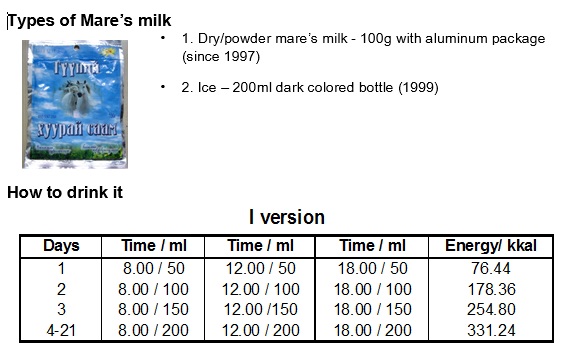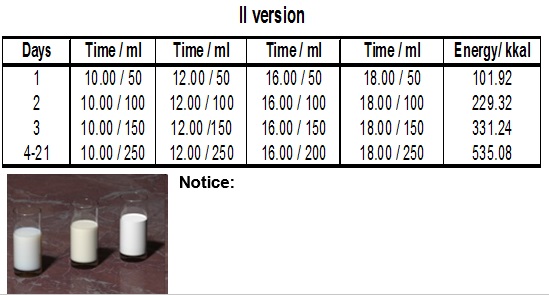History
• Mare’s milk is an ancient beverage.
• In Mongolia 13th century Chinggis khan was used for soldier before the battle field
• In Russia before Revolution has been used Mare’s milk Sanatorium for the anti Tuberculosis.
Milking season
• In Mongolia, the milking season for horses traditionally runs between mid-June and early October. During one season, a mare produces approximately up to 500-700 L of milk. Every 2 hrs during daytime and 6-8 times per day.
Where do we use mare’s milk
• Mongolia, Kazakhstan and Kyrgyzstan
• Turkey
• Germany
• Belgium,
• France,
• the Netherlands and
• Norway.
The composition of mare’s milk
• Fat
• Sugar
• Protein
• Minerals and vitamins
• Enzyme
Fat
• It has a lower fat content and large amount of short, long chained polyunsaturated fatty acids.
• Content of Omega-3 fatty acids (alfa linolen acid) are high. It is important to growth and reproduction of skin, learning ability, normal conditions in the retina and vision.
• More content of olein, palmitin and octadecatrien acids
• Fat-resembling substances that contribute in the transfer of certain nerve impulses. Among others is the regulation of blood pressure.
Protein and enzymes
- Mare’s milk is, together with human mother’s milk, classified as one of the types of albumin-milk.
- Nourishing (nutritional) effect -Casein content: 1.3 %
- Whey-proteins: 1.0 %
- Digestive -When fermented/leavened, the curd of mare’s milk creates water solvable flakes. This is easy to digest.
- The essential aminoacids constitute 42-58% of all aminoacids in mare’s milk
- Antibacterial effect –lysozyme
- Immunoprotective- α- lactoalbumin 3,5 more than cow’s milk, Lactoferrin, IgA, IgG, IgM,
Sugar
• Lactose (disacharide) content: 5.8g (per 100 g)-contains the “bidifus-factor”. Gut protection against infection
• Glucose content: 6.7% -is important function related to the body’s absorption of calcium and it also prevents storage of fat in the liver.
Minerals and vitamins
• Contents of vitamins –A, B1, B2, PP, B15, B12, C and E.
• Mare’s milk contains more vitamin C, A, B1, B2, and B12 than cow’s milk.
• It contains magnesium, potassium, nitrogen, calcium, phosphorous and sodium (Mg, K, N, Ca, P and Na).
• Calcium contents is close to the optimal absorption of calcium in humans.
Mare’s milk contains enough carnitin to prevent the malnutrition of infants


• If diarrhea is occurred more than 2 days should reduce dosage of mare’s milk.
• Day by day can increase dosage of mare’s milk in order to adaptation for GI tract.
Method of use:
• 1). Dry/Powder (100 g)
• 1 table spoon and dissolve 80-100 ml boiled water and 2-3 times a day, 20-30 min before meals
• 2). Ice (200-250 ml)
• Before using should shake it, after defrost can be drink. First day 100 ml, second day 200 ml, 3-5 times in a day.
Research works:
• Composition of mare’s milk (R. Indra, 1965)
• Aminoacids in a mare’s milk (N. Jamsranjav 1971, Ts. Baldorj, 1989)
• A comparative study between mare’s milk and human breast milk (B. Sukhbaatar, 1992)
• Protein and other protein fraction in mare’s milk (Sh. Jadambaa, 1991)
• Mineral composition in mare’s milk (B. Ichinkhorloo, 1992)
• Chronic dermatitis (S.Otgonjargal, 1997)
• Mare’s milk treatment in Chronic viral hepatitis (S. Badamjav, 2000)
• Protein fraction improvement patients with chronic hepatitis during mare’s milk treatment (R.Baigalmaa, 1997)
• Mare’s milk treatment in patients with chronic hepatic diseases (B. Dagvadorj et all 1997)
• In 57-94% of cases was improved Clinical and biochemical datas
• (G.Solaroli ºt all: Review. Composition and Nutritional Quality of MM, Ital.J.Food Sci n.1,1993)
• Premature infants
• Patients with post operative status
• 8-15 days treatment of mare’s milk in special farms
• Sanotorical meals for adult (rich content of casein, albumin, lysosym and vitamin C less content of lactoglobulin, lactoferrin ëàêòîôåððèí,
• Unsaturated fatty acids, phospholipids and Ca,P
• Good result for children’s renal function (nitrogen, content of mineral)
• (Prateek J, Gupta S.K, et all: Nutritional Potentiality of MM, Indian Dairyman, 50,1998)
• Mare’s milk and treatment options:
• Peptic ulcer disease 56%-34,
• Chronic hepatitis, 87% - 75%
• Chronic cardiac insuffiecency: diuretic effect and support cardiac pump function, to reduce peripherial vessels resistance




